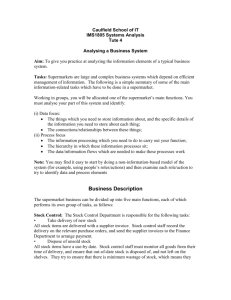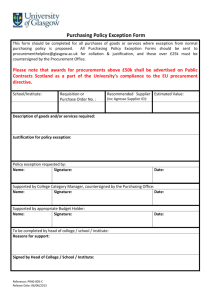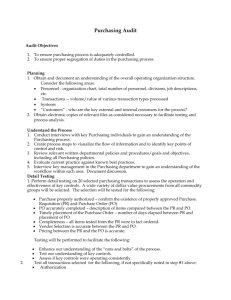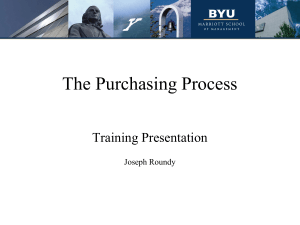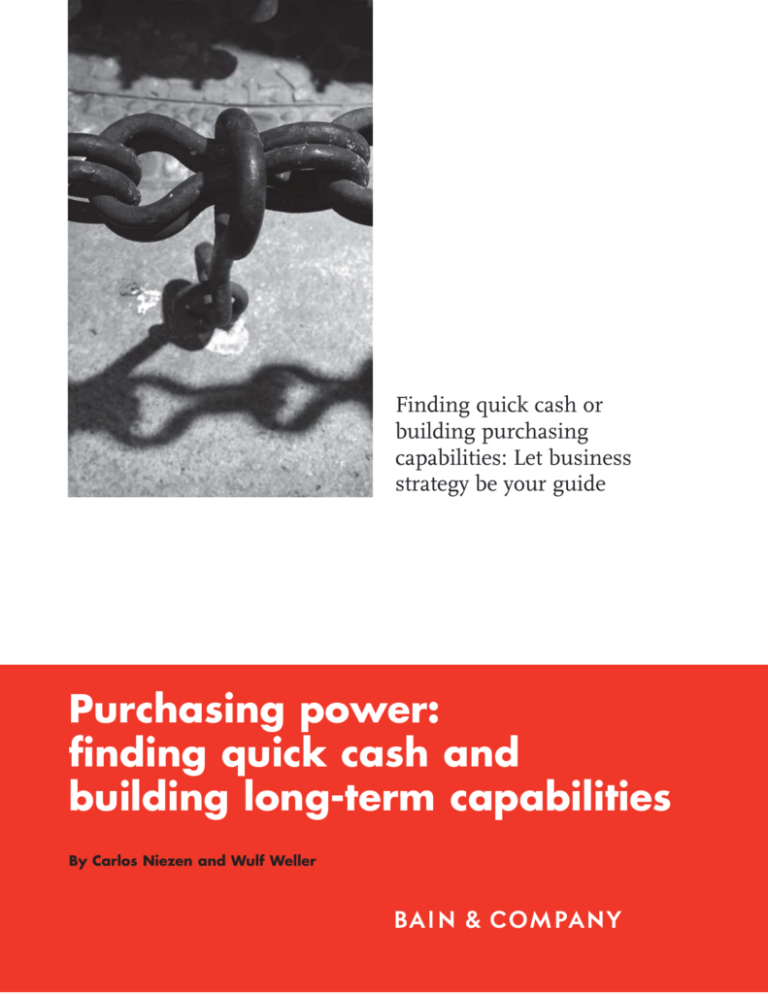
Finding quick cash or
building purchasing
capabilities: Let business
strategy be your guide
Purchasing power:
finding quick cash and
building long-term capabilities
By Carlos Niezen and Wulf Weller
Carlos Niezen is a partner in Bain & Company’s Mexico City office.
Wulf Weller is a Bain & Company partner in Munich.
Copyright © 2009 Bain & Company, Inc. All rights reserved.
Content: David Diamond, Elaine Cummings
Layout: Global Design
Purchasing power: finding quick cash and building long-term capabilities
Finding quick cash or
building purchasing
capabilities: Let business
strategy be your guide
Where do they typically go wrong? Based on
As the effects of the turbulent economy
spread across virtually every industry, companies are looking for cash. There’s no easier
way to generate quick cash without painful
layoffs than to find cost savings in purchasing.
The purchasing of goods and services is one
of the largest, if not the largest cost category—
for most businesses it represents up to 50 percent
of their total expenses. And the savings can be
substantial. In our experience, companies taking a systematic approach can save 5 percent
to 30 percent from the addressed cost base.
category to meet this year’s cost reduction tar-
The trouble is, in economic downturns most
companies are doing a balancing act of finding
short-term cash and building long-term capability. Do they devote their efforts to generating fast money through measures like restructuring agreements with existing suppliers? Or
do they opt for investing in them to build the
broad purchasing capabilities that will help
the company come out of the recession with a
stronger competitive position? Too often companies think they need to choose between the
two. Or they find themselves swerving from
guardrail to guardrail—devoting too much
energy first to one, then to the other.
Acting under pressure they often take reflexive actions that end up damaging them in the
mid- to long term. They fail to align their purchasing strategy with their corporate strategy.
They grab whatever costs they can for shortterm gain (in some instances even driving
promising suppliers to the brink of bankruptcy),
when slightly more effort would deliver better—
and lasting—results.
our observations, companies instinctively take
a short-sighted, bottoms-up and transactional
approach to identifying savings targets. The
question is often: “How much money can we
squeeze right now from our suppliers in each
gets?” Limited by their experience, they’ll determine which of the purchasing cost-saving levers
they haven’t used—renegotiating contracts
with suppliers, ordering larger volumes,
using electronic auctions—and then estimate
how much they can save by using them.
Afterwards, they will implement these tactics.
But costs eventually creep up again since they
have failed to implement any sustainable measures to ensure that these benefits stick.
Consider the example of a US automaker, currently struggling to stay afloat. In an effort to
reduce costs, the company continuously squeezed
prices from key suppliers beyond what the
suppliers could really afford. One of the main
suppliers of shocks and struts acceded to the
pricing pressure in order to retain the business.
In fact, it priced its products to the automaker
at cost. But the supplier compensated by increasing its prices of shocks and struts in the aftermarket. Not surprisingly, the main buyers of
after-market products from this supplier were
the dealers in the automaker’s network and
the consumers. In the end, the automaker was
able to price its cars out of the factory lower
than competitors’—but those cars earned a reputation for having higher maintenance costs, and
thus a higher total cost of ownership.
Companies can take a more effective, factbased and strategic approach to purchasing
while also achieving quick savings. The process
involves addressing four questions:
1
Purchasing power: finding quick cash and building long-term capabilities
•
What cost reductions, service levels, quality
and innovations should purchasing contribute
in the support of the company strategy?
•
What can purchasing do to generate cash for
the business within three to four months?
•
What can purchasing do to improve the
company’s competitive position beyond
three to four months?
•
How do you ensure the results achieved
don’t erode over time?
This definitely is an area where companies
stand to make gains. Most companies readily
admit they lack the ability to optimize their purchasing costs by selecting the most competitive
suppliers or striking agreements that deliver
maximum value. When Bain & Company surveyed 60 executives from a range of industries,
85 percent said their companies lacked bestin-class purchasing capabilities. (See figure 1.)
We’ve identified an approach that allows companies to build supply-management capabilities
while also addressing their short-term needs
for cash and profits:
Sizing the opportunity: What cost
reductions, service levels, quality and
innovations should purchasing contribute
in the support of company strategy?
When it comes to purchasing, most companies instinctively think about how to quickly
generate cash. Some companies think about
how to boost their long-term purchasing capabilities. Strategic supply leaders consider
both—using the company’s overall strategic
goals as a starting point for defining targets or
strategies for their purchasing departments.
For example, a company focused on bringing
innovations to market might be more interested in speed, service levels and innovations
coming out of the supply base. A company
Figure 1: Companies readily admit they can improve purchasing capabilities
Percent of companies that believe they achieve lowest costs and have worldclass purchasing capabilities
30%
20
14%
15%
10
0
Costs are as low as they can be
2
Worldclass capabilities
Purchasing power: finding quick cash and building long-term capabilities
intent on being the low-cost leader in its
industry would be most interested in suppliers that offer the lowest cost, regardless of
other considerations—typically large and lessflexible suppliers.
In either case, sizing—and understanding—
the opportunity for purchasing gains is the
first objective of strategic purchasing.
As a CEO, how can you objectively determine
how much of your cost-saving targets can
be delivered by purchasing—and link them
to strategy?
Consider the approach taken by a company
we’ll call FoodCo. The company had grown
through acquisitions—more than 40 since
the early ’90s—and had run out of targets in
its largely consolidated industry. Therefore, it
wanted to use its considerable size and continue
generating earnings-per-share growth—something of a challenge given relatively flat overall
growth for one of the company’s major products, and a decline in per-capita consumption.
The company’s chairman set his sights on
using FoodCo’s scale to create a cost advantage, starting with developing purchasing
capabilities its competitors couldn’t match. His
mandate was to make the most of the company’s
volume to get supplier deals, to standardize
purchasing items—centralizing wherever
possible—and to run efficient processes.
The company used some outside-in metrics to
determine the size of the purchasing performance gap in important product categories. Key
to its success was FoodCo’s quantitative
approach: the company quickly conducted experience curve and make-vs.-buy analyses, and
used broad benchmarking—looking beyond its
company and industry for benchmarks—to
set real targets. Thus, FoodCo was able to not
only strategically set saving targets for purchasing in one of its most critical categories
but also turn around supplier negotiations in
its favor. (How did they do it? See sidebar
“Finding free cash in plastic bottles.”)
Quick hits: What can purchasing
do to generate cash for the business
within three to four months?
Control demand for internal use
and costs
Once they size their savings, service levels,
quality, and cost targets, strategic supply leaders typically look inward for places to cut
demand. Instead of just looking to suppliers
for price cuts, the first thing a company can do
is to look internally and quickly identify means
that are entirely within its immediate control.
Even though there are quick opportunities
across the company, generally speaking, companies have the most options for shrinking
demand volume for indirect supplies—everything from travel to office equipment to janitorial service.
When it comes to shrinking demand for indirect costs, everything’s on the table for consideration. Companies can rapidly control demand
and reduce waste through such measures as
tighter expense policies and approvals, more
usage and cost awareness and accountability—
such as publicly posting travel-expenses and
cell-phone-usage accountability. Other options
include limited use of corporate purchasing
cards and zero-based budgeting. Often the
right policies and contracts already are in place,
but compliance is not—in tough times, just
enforcing compliance can make the cash
register ring.
Companies can cut travel for internal meetings
in half by using videoconferences. They can
increase 14-day advance purchases, use a lower
tier of hotels, enforce compliance with preferred
3
Purchasing power: finding quick cash and building long-term capabilities
hotel vendors and reduce daily meal allowances.
They can put in place stricter approvals for
staffing services—and analyze the top 20 percent
in terms of cost with the aim of driving those
contracts down 60 percent to 80 percent. They
can save on facilities costs by renegotiating
leases with less than three years remaining,
trading lower rates for lease extensions. For
owned buildings, they can apply for property
tax reassessments—with the help of firms
that work on contingency. They can cut back
on janitorial and landscaping, standardizing
specs or re-bidding with local contractors. One
US bank was able to save $3.1 million within
a year through such means. Other tactics to
quickly unlock savings from indirect purchases:
stopping all non-essential purchases and
revising permission criteria.
can eliminate off-contract buying, drive down
purchase prices with reverse auctions and substitute for lower-cost items like printers. In
some instances, with the right suppliers in
place, it is possible to begin price negotiations
to immediately close cost gaps. But it’s always
important to balance short-term and long-term
considerations. Squeezing quick cash out of an
important supplier generally isn’t worth it if it
will come back to haunt you. Consider the
automaker that saved on the cost of shocks
and struts but wound up with a reputation for
selling cars with high maintenance costs.
While shrinking demand and unit prices for
indirect costs, companies should take on the
challenge of pursuing per-unit cost reductions
The next step is to reduce unit prices for indirect
for direct supplies—those that are integral to
supplies. To achieve such savings, companies
a company’s product or service. (See figure 2.)
Figure 2: Companies can achieve 10% to 20% savings through purchasing initiatives
Expected savings (range of purchasing cost savings*)
29%
30%
29%
High
20
Target
10
Low
0
Total
*Of addressed costs
Source: Planet Retail
4
Year
Purchasing power: finding quick cash and building long-term capabilities
On firm footing: What can purchasing
do to improve the company’s competitive position beyond the first quarter?
Consolidate and integrate with the most
competitive suppliers
A downturn is the time to consider whether you
are sourcing from the right suppliers to support your strategy. If your company is sourcing
from the right suppliers, then it is important
to ensure that you’re consolidating volumes
for maximum savings. This can be done by
evaluating the supplier’s performance against
experience curves or a make-vs.-buy analysis,
which should help to determine targets—and
can generate quick hits. If your company is not
sourcing from the right supplier, based on the
experience curve and make-vs.-buy analyses,
then it is time to search for new suppliers. In
addressing the question above, many companies evaluate suppliers primarily based on
short-term price. In contrast, leading companies will pick long-term winners by assessing
total cost of ownership instead of invoice
price. They also consider several additional
factors in the selection process, such as R&D
capabilities and ability to innovate, quality of
management, service levels, industry position
and willingness to collaborate across critical
fronts. (See figure 3.)
The relative importance of each of these factors
should depend on a company’s strategic goals.
If your company wants to be a low-cost leader,
total cost of ownership will be a key selection
criterion. If your strategy is to be first to market and on the leading edge of innovation,
other factors may trump total cost of ownership in importance.
Finally, the strategic supply function can
make an important contribution in the way a
company thinks about its indirect-cost structure.
Figure 3: Our approach to procurement transformation
Size the gap
• Topdown gap: Ecurve, scale curves
and make vs. buy to identify
topdown competitiveness gap
• Bottomup gap: Identification of
category opportunities through quick
analysis and prior experience
• Validate through benchmarks:
Compare prices, terms and
conditions, quality standards,
and innovation options
Seize the prize
Stick to results
• Control demand: Defer purchases
or set policies
• Strategy: Procurement aligned with
company strategy
• Consolidate and integrate with
most competitive suppliers:
Ensure lowest costs with
“winning horses”
• Category knowledge management
and performance tracking:
Category strategies developed
with market and internal facts
• Evaluate alternatives: Consider
Total Cost of Ownership (TCO)
instead of invoice price only
• Processes and decision rights:
Clear roles and responsibilities
for key decisions
• Simplify design: Substitute to
reduce complexity costs
• Organization and people:
Aligned with supply markets
and internal structure
• Control and hedge risk: Actively
manage exposure
5
Purchasing power: finding quick cash and building long-term capabilities
Applying the same make-vs.-buy analysis to
overhead functions can help a company determine whether it is time to outsource non-core
business processes. Outsourcing can improve
both efficiency and effectiveness through such
gains as better controls and more-consistent
results. When considering outsourcing, purchasing should support the business case,
statement of work definitions, vendor assessment as well as the Request for Information
and Request for Proposal processes. In most
cases, it takes more than six months to achieve
gains from outsourcing.
When a company chooses the right suppliers
capable of serving its strategic goals, collaboration could spell the difference between building long-term purchasing capabilities that competitors can’t match and suffering the ill effects
of sending a supplier down the path toward
bankruptcy. If you have the best suppliers,
there’s no point in alienating them or driving
them out of business by forcing them into a
lower price bracket. So there is an important
question to ask: Is there a way to negotiate for
key products that puts us in a win-win situation?
By placing value on suppliers that are willing
to collaborate, retailer Macy’s is able to both
achieve quick infusions of cash and form supplier relationships that are mutually beneficial
for the years ahead. For example, Macy’s and
a supplier jointly developed an alternative supply
chain to speed time-sensitive products to stores.
It also collaborated with a supplier to develop
three separate apparel items at price points
the retailer was confident would sell extremely
well—and did.
Consider total cost of ownership
When comparing suppliers’ costs, many companies place too much emphasis on the
invoice price. That oversight paints a notoriously inaccurate picture of the cost impact.
6
Instead, leading companies look at the total cost
of ownership. That means considering quality,
service levels, lead times and how the purchase
fits into a bigger scheme of things. For Korean
construction company SK Engineering &
Construction, looking at the paid invoice price
without taking into account probable fines for
delayed deliveries would lead to the wrong
sourcing decisions. For worldwide buildingmaterials company Lafarge, determining the
total cost of ownership means considering how
many hours a piece of equipment will likely
be in operation. The total cost per hour is estimated from around €100 if the equipment is
used for 2,000 hours to €20 if the equipment is
used for 14,000 hours or more. The company
compares suppliers not at the invoice price,
but at the estimated overall cost of ownership
assuming the optimal lifetime.
Simplify the design, the product and the
supplier base
We can’t emphasize enough the long-term
benefits to be gained by actively managing the
level of design and sourcing complexity. We
find time and again that companies involve
purchasing too late in the game in the product
development process, and fail to consider the
cost impact of their design decisions. Take the
case of a cardboard-box maker that waited
until after it had selected a supplier to call in
the purchasing department to negotiate the
contract and try to save on costs. Had purchasing
decisions been considered at the design stage,
the company would have had a better chance
at assessing design trade-offs, with a greater
impact on costs. For example, the team could
have considered using two colors instead of
three, and a different printing process. One
important insight we have seen over time is
that organizations often overlook the potential
savings of “upstream” levers like design simplification in favor of “downstream” activities
like switching suppliers.
Purchasing power: finding quick cash and building long-term capabilities
Control or hedge risk with customers,
suppliers or third parties
Companies with world-class purchasing capabilities understand their level of exposure by
type of risk and their preferred level of risk tolerance. Based on that knowledge, they rely on
different hedging mechanisms to keep exposure
in check—using corporate strategy as their
guide. Among the measures they can use:
passing on raw-material price movements to
customers or implementing margin-sharing
with suppliers. Or when appropriate, vertically
integrating, deploying flexible production
schedules to meet supply contracts, shifting to
input substitutes when supply is short and
building inventories when prices are favorable. They also can postpone capital investments and use such financial tools as forwards and options to hedge risk—delivering
benefits to both the profit-and-loss statement
as well as the balance sheet.
Sustaining benefits: How do you
ensure the results achieved don’t
erode over time?
With multiple business units, functions and
processes coming into play, most companies
face the issue of managing purchasing organizations that become increasingly ineffective
as they grow in complexity. This not only precludes continuous improvements but also
reverses gains attained in focused efforts. To
keep the benefits coming, leading companies
ensure that there is a clear owner for each key
decision, and that decisions are made swiftly,
at the right level, and with the right inputs.
(See figure 4.) And once decision rights are
established, they install a higher caliber of
purchasing talent—and implement the right
targets, tools, and metrics to manage performance. As with every other element of purchasing strategy, what you choose to track and
measure—and how you compensate purchas-
Figure 4: World-class procurement organizations
Strategy
• The role of procurement is aligned with overall strategy
• More aggressive and objective value aspirations around cost reduction, innovation, quality and service targets
• Procurement works with the rest of the business as one team to create value, differentially focusing on highvalue categories
and levers
Knowledge management and
performance tracking
Processes and decision rights
• Clear roles and responsibilities for
• Spend factbase in place, and
each decision to ensure high
opportunities identified and prioritized:
decisionmaking “metabolism”
– Spend analytics: Historical spend
by BU, supplier, geography,
• Processes codified and embedded
category and so on
within procurement and the business,
– Market intelligence: Inflation data
and supported by standardized etools,
gathering, supply market analysis,
templates and systems
price and performance bench
marking and “target cost” modeling
• Consistent supplier governance
model by tier
• Progress against priorities tracked
through a holistic management
• Focus on cycletime reduction and
information dashboard
reduced process variability (Six Sigma)
Organization and people
• Purchasing organization aligned
with corporate structure and supply
market, with separate strategic and
tactical purchasing decisions, and
crossfunctional teams
• Talented individuals in most critical
leadership roles
• Capable organization continuously
developed through ongoing learning
and development (training, mentoring,
academic programs)
7
Purchasing power: finding quick cash and building long-term capabilities
ing talent—should be dictated by your corporate strategy. Even though purchasing often is
responsible for managing up to 50 percent of
a company’s total cost structure, too often
companies fail to make the necessary investments to hire top talent, support them with
the necessary tools, and clarify accountabilities.
Lafarge, the worldwide building-materials
maker, revised its decision-making process by
putting in place a new organization aimed at
helping it sustain savings from all categories
of purchases (Capex, energy, industrial goods
and services, indirect purchases). It defined what
decision rights belonged above and below the
business unit line, and reinforced cross-functional input on key purchasing decisions. Once
decision rights were set, the company established a process to ensure all stakeholders were
involved at the right level at the right time,
and that it had the right tracking mechanisms
to measure compliance and performance.
Setting up the right tracking mechanisms was
key to reinforcing purchasing credibility and
making sure that purchasing savings were
materialized into the business units’ P&L and
cash flow.
Such careful attention to decision making and
tracking results means Lafarge is well-positioned to keep purchasing costs from creeping
up long after the economic turmoil subsides.
Like other purchasing leaders, it has learned
that it doesn’t need to choose between finding
quick cash and building solid purchasing capabilities. It can achieve both. That meant determining the level of purchasing improvements
needed to further corporate strategy, identifying means of finding quick cost savings and
opportunities for longer-term gains that also
move the company toward its strategic goals,
and imposing the organizational discipline
required to sustain the results.
8
Purchasing power: finding quick cash and building long-term capabilities
Finding free cash in plastic bottles
When FoodCo learned that the supplier of the majority of its plastic bottles was raising prices for
many of its SKUs, the company calculated the price increase would add $7 million a year to its
costs. FoodCo was considering accepting the proposed price increases. But first it decided to
conduct experience curve and make-vs.-buy analyses—a typical step taken by companies with
solid purchasing capabilities, conducting a category-by-category search for savings.
Experience curves (e-curves) show how unit prices should decline as volume grows. Our internal
analysis of more than 100 products with data that goes all the way back to 1946 shows that
experience curve costs and prices typically decline 20 percent to 30 percent for each doubling
of experience in a particular good or service. Experience curves can be generated for an industry
or for an individual company using internal purchasing data or external market data. Companies
use the analysis to determine their own performance gap and that of their suppliers. E-curves provide a valid picture of what companies should be paying for each unit they buy and what their
suppliers should be charging. Experience curves also provide a guide for long-term contracts,
and help determine what the supplier should be able to charge in the future. While many companies look for across-the-board discounts, leading companies differentiate what they ask for
based on the specific economics and experience curves of each supplier industry.
Purchasing leaders also use make-vs.-buy analyses to quantify cost targets. The objective is to compare the cost of purchasing a good or service vs. producing it in house. The exercise sheds light on
a company’s ability to achieve cost savings and helps pinpoint the true costs its suppliers should
be charging. It is particularly useful for companies facing unstable, monopolistic or oligopolistic
sources of supplies.
At FoodCo, the e-curve analysis indicated that rather than increasing its prices, the supplier
should be dropping its prices by 0.76 percent per year, based on its ability to more efficiently
produce plastic bottles each year. Meanwhile, the make-vs.-buy analysis found that by in-sourcing all the bottle production of this supplier it could generate a net present value of $50 million.
With this information, the CEO of FoodCo communicated the results to the supplier, but gave
them one more chance. Faced with the quantitative evidence, and the prospects of watching
FoodCo make its own bottles, the supplier decided to decrease its costs rather than increase
them. The end result: FoodCo slashed costs by $7 million per year.
Purchasing leaders like FoodCo also evaluate their ability to achieve their targets by benchmarking their purchasing capabilities against best-in-class competitors and, often times, against other
industries. And when sizing targets, these companies will benchmark a range of factors in addition
to unit price, such as quality and service levels.
Bain’s business is helping make companies more valuable.
Founded in 1973 on the principle that consultants must measure their success in terms
of their clients’ financial results, Bain works with top management teams to beat competitors
and generate substantial, lasting financial impact. Our clients have historically outperformed
the stock market by 4:1.
Who we work with
Our clients are typically bold, ambitious business leaders. They have the talent, the will
and the open-mindedness required to succeed. They are not satisfied with the status quo.
What we do
We help companies find where to make their money, make more of it faster and sustain
its growth longer. We help management make the big decisions: on strategy, operations,
technology, mergers and acquisitions and organization. Where appropriate, we work with
them to make it happen.
How we do it
We realize that helping an organization change requires more than just a recommendation.
So we try to put ourselves in our clients’ shoes and focus on practical actions.
For more information, please visit www.bain.com
Amsterdam • Atlanta • Beijing • Boston • Brussels • Buenos Aires • Chicago • Copenhagen • Dallas • Dubai • Düsseldorf • Frankfurt • Helsinki
Hong Kong • Johannesburg • Kyiv • London • Los Angeles • Madrid • Melbourne • Mexico City • Milan • Moscow • Munich • New Delhi
New York • Palo Alto • Paris • Rome • San Francisco • São Paulo • Seoul • Shanghai • Singapore • Stockholm • Sydney • Tokyo • Toronto • Zurich





